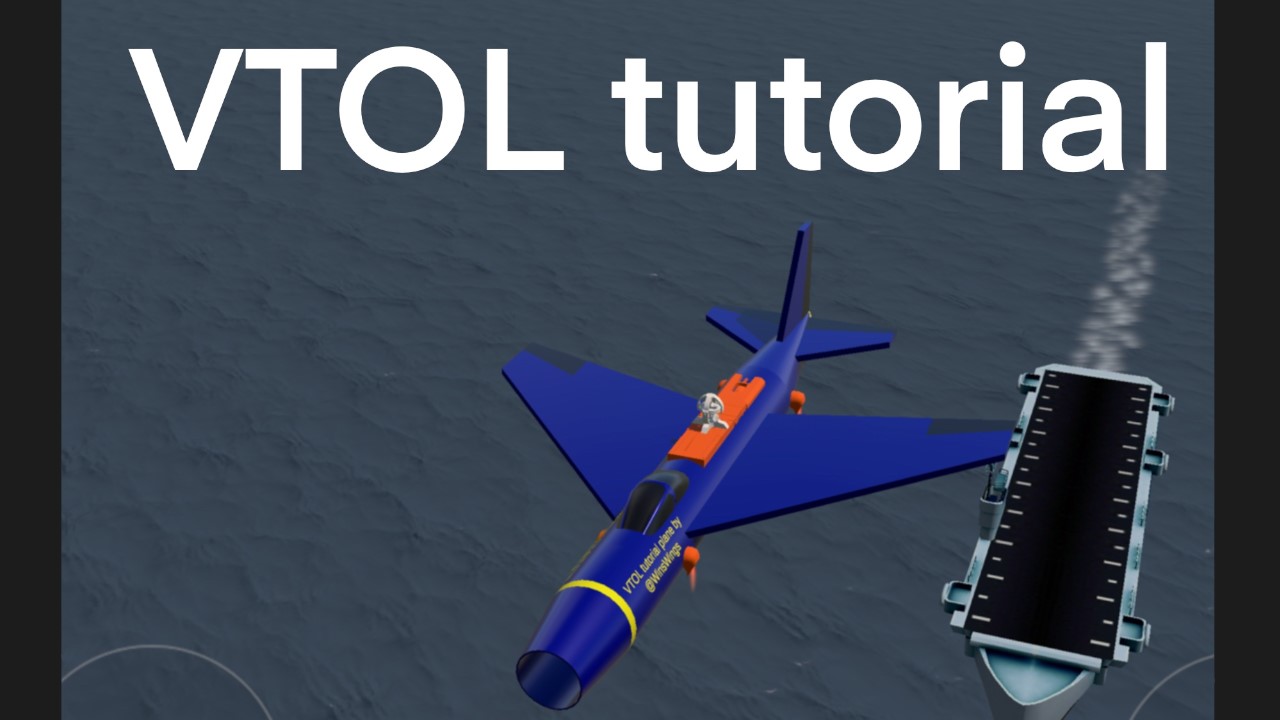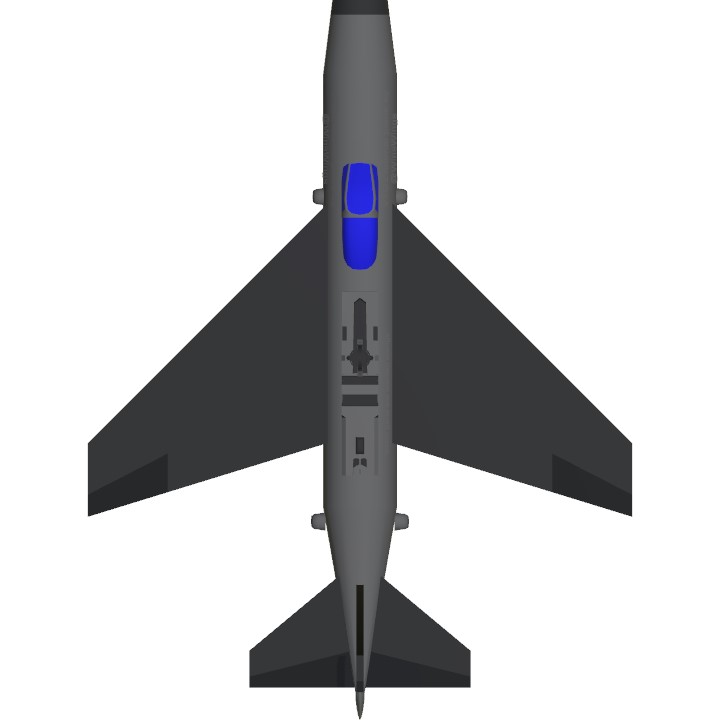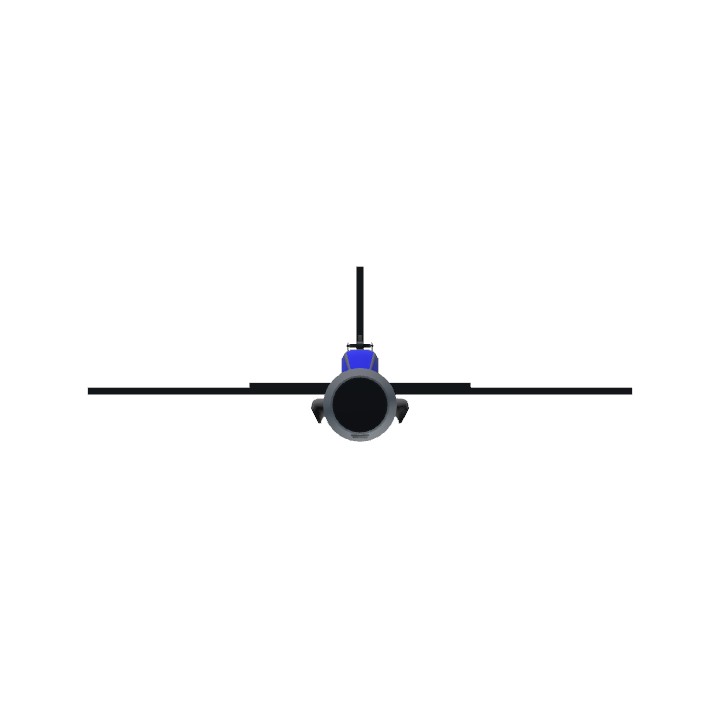
Visit advanced VTOL planes for inspiration
- Barracuda-Mark-II
- Dornier-Do31E
- VTOL-Do-228-X
VTOL Tutorial for Beginners
As a thank-you note to my followers, I have built this simplest VTOL plane for those who have difficulty building VTOL planes. This basic tutorial will help you with more complex VTOL makes on your own.
The VTOL parts, Counterweight, and gyro, are color-coded in this tutorial plane. There are only 26 parts in this plane since I reduced the minimum part count to make it the easiest possible.
This tutorial is still under development, and I will add more information if I can. Also, all suggestions are welcome.

VTOL parts are color-coded ORANGE,
The Gyro is colored white and makes it visible. You can hide it in the real build.

Weighted parts are color-coded YELLOW
How to fly
or the concept of VTOL
Throttle 100%, and it will slowly hover. then, move the VTOL slider up little by little. So easy. This will explain the physics -
- Takeoff: Throttle 100%

. - VTOL +25% will give the plane forward thrust and gain speed

. - VTOL +100% Full peed, VTOL nozzles are pushing backward

Negative VTOL: This is how to slow down, or even a backward movement if you overdo this -

How to make a nicely hovering VTOL plane
by Win'sWings
1) Build a decent flying plane first
at least it should fly decently. Make sure it is not too nose-heavy or tail-heavy. It should maintain a good flight path. Use the "Bendit Airport approach" and test how it glides without any engines.
2) Make a test flight without the engines
If it glides nicely, let's add the VTOL engines. Blasto VTOL (XML name: Engine-Jet-5) is the VTOL engine you must use. Open the "eye" icon to see the CoM, CoT, and CoL (Center of Mass, Center of Thrust, Center of Lift). Add the Engine close to the Center of Mass. VTOL plane is all about Physics. (I am unsure if someone could edit XML and make it good - but I prefer working with aviation laws and physics - which makes it more enjoyable to me)
3) Power Weight ratio: (the powerMultiplier variable in XML)
Check the Airplane Properties by clicking the "i" icon, and check for the Power Weight ratio. This ratio should be slightly greater than 1. (Note: I made the ratio 1.08 by editing the Blasto VTOL engine power in XML for this tutorial airplane.)
If the Engine is too powerful, the plane will jump without control. But if the power-weight ratio is less than one (which means the engine output thrust is lower than the plane's weight), the aircraft will not leave the runway.
For the fake engines used for the visual purpose: Change their power to "0" using powerMultiplier.
4) Add four VTOL nozzles -
Place them at equal spacing with the CoM
5) VTOL RCN rings at least under the nose and tail -
This will help the nose up and nose down of the plane at low speed or hovering
Now test it - check the CoM/CoT and CoL meet the principle.
6) A gyroscope -
VTOL plane sucks without a gyro, no matter how you try for the balance.
Now test again - check the CoM/CoT and CoL meet the principle.
7) adjusting weight.
The nose should be heavier. So add weight IF you need it.
Remove some weight from unnecessary parts.
8) Fuel tank and weight shift
Fuel weight will change the CoM when the tank is empty. So remove the fuel if it is away from the CoM. I recommend using the "Fuel Tank" - edit the capacity in XML if you want more (default value is 75-gallon)
Fuel in the Wings goes the same story. I would remove them all.
Other useful forums which is a bit different form my concept:
Tip for VTOL Builders build without dead weight mass scaling or CoM shifting
I hope this tutorial may be useful for you.
Thanks for UPVOTES! I appreciate your support.
Specifications
General Characteristics
- Created On iOS
- Wingspan 23.9ft (7.3m)
- Length 32.0ft (9.8m)
- Height 8.0ft (2.5m)
- Empty Weight 5,637lbs (2,557kg)
- Loaded Weight 7,221lbs (3,275kg)
Performance
- Power/Weight Ratio 1.008
- Wing Loading 35.9lbs/ft2 (175.3kg/m2)
- Wing Area 201.1ft2 (18.7m2)
- Drag Points 894
Parts
- Number of Parts 26
- Control Surfaces 5
- Performance Cost 109






Huh, at lease someone is reading this
@ToeTips I see
@WinsWings
Yeah, I checked this out before I made the Narwhal. But the plane is more artificial with it's VTOL.
@ToeTips you might interested in this
@standardCookie my pleasure
Thank you
@ssenmodnar well, it depends on situation, You can change the weight (YELLOW) and see how
Actually ideally the CoM would be below the CoT
@MrCOPTY yes, I want to explain even more detail, but well... I am not sure people have enough interest. This is not much XML, just plain physics
@WinsWings I Read Stuffs Here, Nice & Very Specific, Hope Guys Learn Smth From
@MrCOPTY Ha ha Thanks
👀